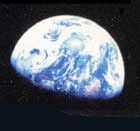|
Acid in the ocean
The graph of global heating has been going up in step with the
graph of atmospheric carbon dioxide, though roughly, because jags
in the graph are caused by lesser factors, such as volcanoes and
world wars. So there is room for some argument about the details.
But the graph of
ocean acidity goes up exactly in step with the increasing carbon
dioxide. It has to. Carbon dioxide in contact with water dissolves
into it and forms carbonic acid. More carbon dioxide, more carbonic
acid. We know how much more carbon dioxide gas we are generating,
we can predict how much more acidity that will cause, we can measure
the pH (acidity) of the oceans, and it keeps to prediction.
There is no room
for argument about it. And so there is no room for valid doubt about
the whole linked pattern. Human activity has reached a scale at
which it is corroding the thin film in which we, and other creatures,
live.
Increasing acidity
prevents calcium carbonate from forming in the water. Calcium carbonate
is used to make the shells of corals, molluscs, and plankton. Plankton
are the base of the marine food-chain. Coral reefs, the “rainforest
of the ocean,” cover only one percent of ocean area but support
a quarter of all ocean species, and they are already being destroyed
by human activity such as fishing with dynamite, as well as by warming
water. If the acid in the oceans keeps increasing at its present
rate, it will not only hinder formation of calcium carbonate but
dissolve it. Alarmingly large areas of coral reefs have already
gone white, as dead as bones.
(Actually ocean
acidity goes up somewhat faster than aerial carbon dioxide: rivers
add the acid rain caused by power plants; they also add fertilizer
runoff from farms, which cause algal blooms, which decay into carbon
dioxide directly in the water. So we should say that ocean acidity
goes up in step with carbon dioxide in the atmosphere, plus acid
rain and fertilizer runoff.)
return
|

